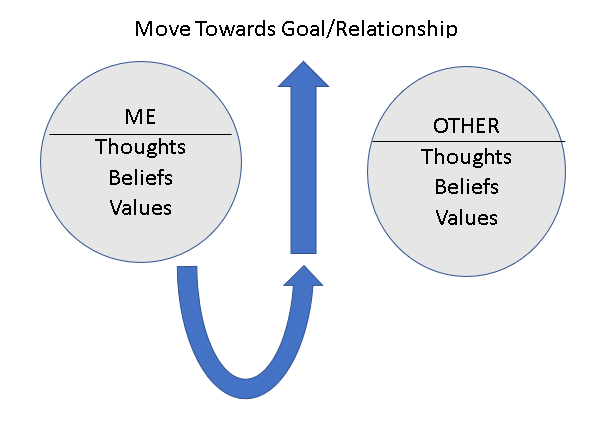Giving Space by Michele Fleming, Ph.D.
Does this sound familiar? You are having a conversation with a friend who holds thoughts and beliefs that are vastly different from yours. Next thing you know, you start to get triggered – a slow rising of the need to be right. To deliver a brilliant rebuttal. Or to defend yourself. The anger and anxiety are rising, and you just can’t stop the words from flying out of your mouth. Or, you simply clam up and decide the cold shoulder is the best strategy.
I recently found myself in this exact situation with a very good friend about the finer points of children returning to school this Fall. And this friend has no children.
Why did I find the need to continue a conversation that was clearly going nowhere? After teaching Dr. Townsend’s didactic on presence for my TLP team the following month, I finally figured out what I needed. A practice in boundaries. And in between two people’s boundaries, there is space.
Giving space means allowing the other person to have his or her own feelings and beliefs. Their thoughts, values, passions, and clearly wrong perceptions are inside of their boundaries. When I feel compelled to change their obvious errors, I am intruding into their realm of the other person’s responsibility. These views are simply not mine to correct, unless I’m at a march or rally. And when I start to get triggered, I’m feeling a threat that’s coming from the other person trying to reach inside of my boundaries. It looks like this:

What is needed is space between those two circles. Social distance in the emotional world. Put a mask on that opinion. Wash your hands of being right. Give the other person the space for what is inside his or her boundaries. They may return the favor, they may not. But you, you become the well-defined-boundaries-master. The person who is firm in his or her own thoughts, beliefs, and values is not in need of change – either from someone else or by intruding into someone else’s definition of right and wrong. When I am well-defined, I simply cannot be threatened by differences.
Then, after you give space, move the conversation towards the reason you are in this person’s company. Maybe it’s simply to enjoy a friendship or a game together. Maybe it’s to get a job done. But you shift the conversation to the goal of being together. It looks more like this:

So, how do you actually do this?
Step one: (other person is talking …)
Say to yourself, “I’m giving emotional space here. I’m listening.” Listen, observe, maybe even ask a question from a curious point of view. It may mean being silent from time to time. Visualize the physical space between you, since really you have six feet to work with. Or the whole internet.
Remember, their opinion is within their boundaries. Not your job to change them.
Step Two: STOP and THINK (a.k.a mindfulness): what is the goal of our interaction today? Is it a business or ministry meeting? Is this a good friend or neighbor? Or, is your goal to simply get through the day in close proximity to a family member? If the value is the relationship or the need to get along, then move to step 3. If the value is to change the other person’s point of view, then you are choosing to be right rather than to be in relationship.
Step Three: Pull the ripcord and jump into your exit strategy: steer the conversation towards the goal and then change the subject. “That does sound interesting, but I don’t want this conversation to ruin our time together. Let’s catch the end of the game. ” Or, “Let’s get back to the project.” If that doesn’t work, then pull out the boundary big guns. Give lots and lots of space. Walk away, leaving the situation and the conversation behind. Nicely.
Think you might need help practicing giving space? We all do! A TLP group is a great place to practice difficult conversations within safe relationships. I’d love to hear from you, and how giving space worked for you.
Reach out at michele.fleming@townsendleadership.com.
www.drmichelefleming.com

Comments 11
Thanks Michelle. Very relevant and helpful!
Glad you found it helpful!
I like that! Giving space to the other person and not feeling like I need to continue a conversation going no where. I agree with building the relationship instead of being right or changing the other person’s mind.
What is a TLP group?
Hi Terry,
A “TLP” group is a Townsend Leadership Group. It’s a group that meets to go deeper into Dr. Townsend’s teachings on his Character + Competence growth model. If you’re interested in learning more, please reach out at michele.fleming@townsendleadership.com.
I like this on the “need to be right.” I have been pretty good about clamming up (letting them continue being wrong without trying to change their thoughts) or disengaging, but I often still felt hooked or threatened. Now I see that I can/should extend the same grace to myself and be alright with not agreeing.
BTW, I often ask how they arrived at their opinion, but it is extremely rare that they bother with asking about how I’ve come to think as I do!
Thanks for that 3 step process!
Thanks!
Great advice! My parents never taught us kids things like this, when we were kids…
Thank you!!! Work in progress!!
Loved your viewpoint very helpful.
Thank you!